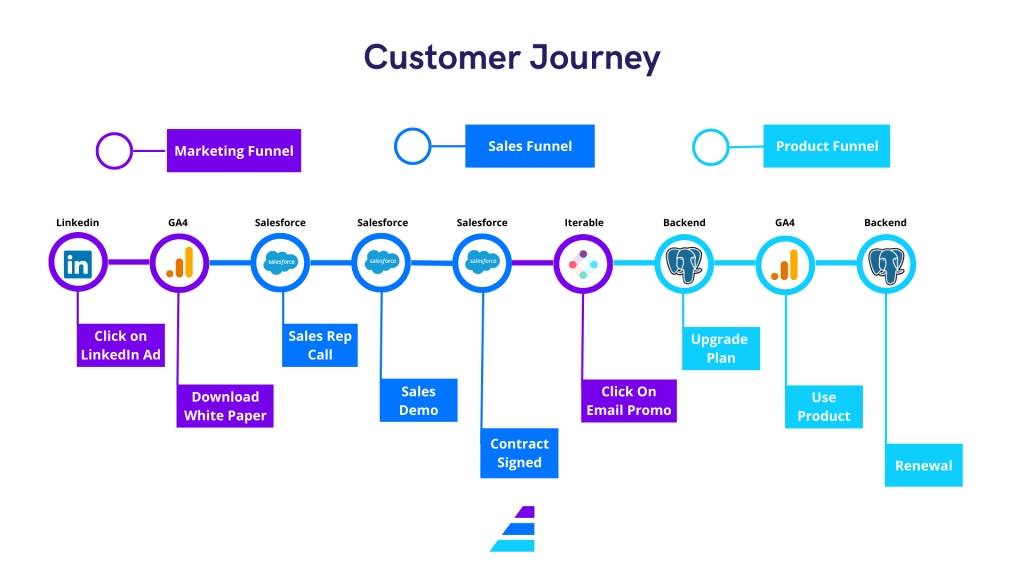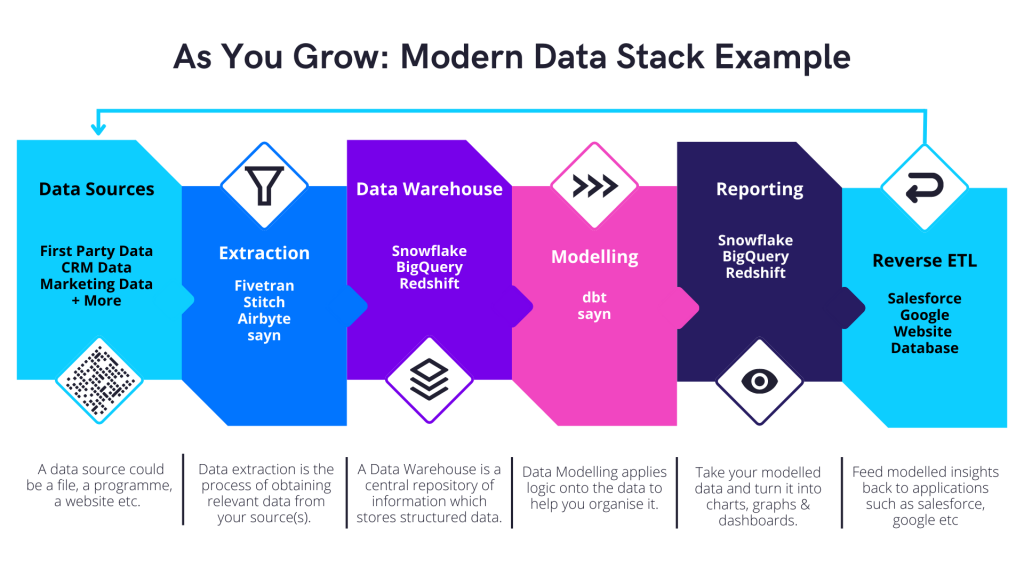Data-Driven Smarketing
Smarketing is the process of merging and aligning sales and marketing team efforts towards common goals: create a streamlined and customer-centric experience throughout the customer journey in order to maximise satisfaction and lifetime value (LTV).
What Data Do You Have?
For any business, we recommend starting with a clear view of your customer journey and map out the data points along the way.

Above is a quick example of a HR platform targeting SMEs. Emily, a co-founder of a growing analytics agency, is spending valuable time doing payroll each month. She clicked on a LinkedIn ad on how to automate payroll, landed on your website, filled in her details and downloaded your whitepaper on this topic. Your sales team followed up with a call and scheduled a demo. Emily loved the platform and signed up for a yearly contract. As she owns an agency, your marketing team decided to share with her a promo via CRM on your latest feature for tracking timesheets. Spot on! Exactly what she needed and she upgraded her plan. She continued to use the product throughout the year and renewed the subscription at the end of the year.
This is a perfect example where the marketing team generates the awareness and interests for your product, sales team cementing that interest into signed contract, marketing team coming back in to upsell and increase LTV.
Below is a quick recap of some of the important information to track with their sources in brackets:
- Marketing Source: LinkedIn Ad (LinkedIn)
- Customer Pain Point: Payroll (GA4)
- Customer Action: downloaded ebook on “How To Automate Your Payroll”. (GA4)
- Company Type: Agency (Salesforce)
- Customer Role: Owner (Salesforce)
- Sales Funnel Flags: Call => Demo => Signed (Salesforce)
- CRM Action: Clicked promo campaign => Upsold on timesheet feature (Iterable and backend database)
- Customer Behaviour: Activity and feature usage (GA4)
- Customer Retention: Year-1 renewed (backend database)
Where Is The Value?
Now you might wonder: yes I have all this data somewhere, how do I make use of it?
Comprehensive Sales Scripts
The more information you have that can help tailor your sales conversation to be more relevant and targeted at the prospect the better. It will help you naturally get closer to your customer, increase conversion and cut down time to deal.
Automated Lists For Email CRM
We talked about a simple strategy to target agency owners to upgrade their subscription plan on the timesheet feature. At scale, you can start building automated cohort lists for various purposes: upsell, prevent churn, move them along the conversion funnel (e.g. list of prospects that did not book a demo).
These lists can be automated into your CRM systems at your desired time interval. From there, you can create your CRM strategies. For example, further segment the list of prospects that did not book a demo by their key pain point so you can tailor the email copy to better get their attention hence increase click through rates and overall impact.
Improve Resource and Budget Allocation
As we described above, Emily became a loyal customer as a result of a series of efforts from various marketing campaigns and sales touchpoints. How do you know which step(s) really moved the needle so you can apply your resources more effectively? First, you need the visibility of all touch points on a user level. From here, you can start testing various attribution models to identify the one most suitable to your business. Make sure to automate the attribution model and related costs so you have clear visibility on the impact and ROI. This will help allocate your resources and budget more efficiently.
How Do I Get There?
I can already anticipate your next question: great ideas but my data is not in a state to support any of these. What could I do to get to value quickly and cost-effectively? Here are our top tips:
Modern Analytics Stack
To ensure data along the customer journey is centralised and transformed into easily-queryable data models based on your unique business requirements, you need a scalable and efficient modern analytics stack. You can see a quick overview in the chart below and here is our previous article on this topic.

Prioritise
It is tempting to do everything at once. However, this approach will delay your time to value. Don’t try to model every metric and data source, instead identify low-hanging fruits and build iteratively. For example, if the biggest value for you now is to improve subscription renewal, then integrate your backend database first to understand customer behaviour and what leads to renewal so you can optimise and monitor effectively.
Democratise Insights
Once you have all the data centralised and modelled, create easy-to-use dashboards tailored for each team so they can monitor the impact of their work. Your dashboards should be interactive, tell a story, and enable any user to explore and analyse the data further.
Reverse ETL
This is a hot topic recently, as some refer to it as “operational analytics”. It allows you to automate modelled insights into any tool (e.g. Hubspot, product frontend). The use cases are unlimited, from creating a personalised product experience, preventing churn, to automating marketing spend. All at scale whilst remaining privacy-friendly.
We hope this article sparked a few ideas on how you can improve the collaboration between sales and marketing and become more data-driven. As always, our team is happy to chat and share more insights. Please feel free to reach out to us at 173tech.


